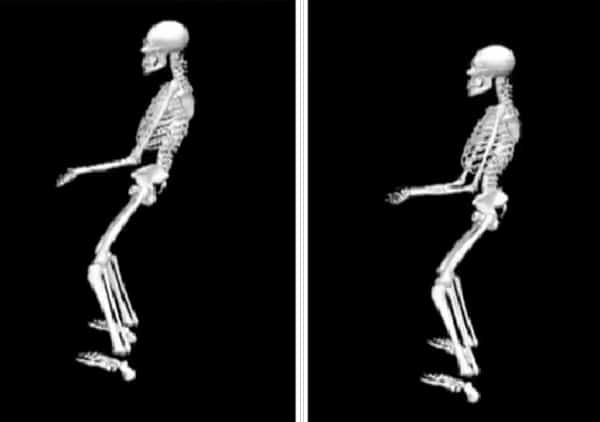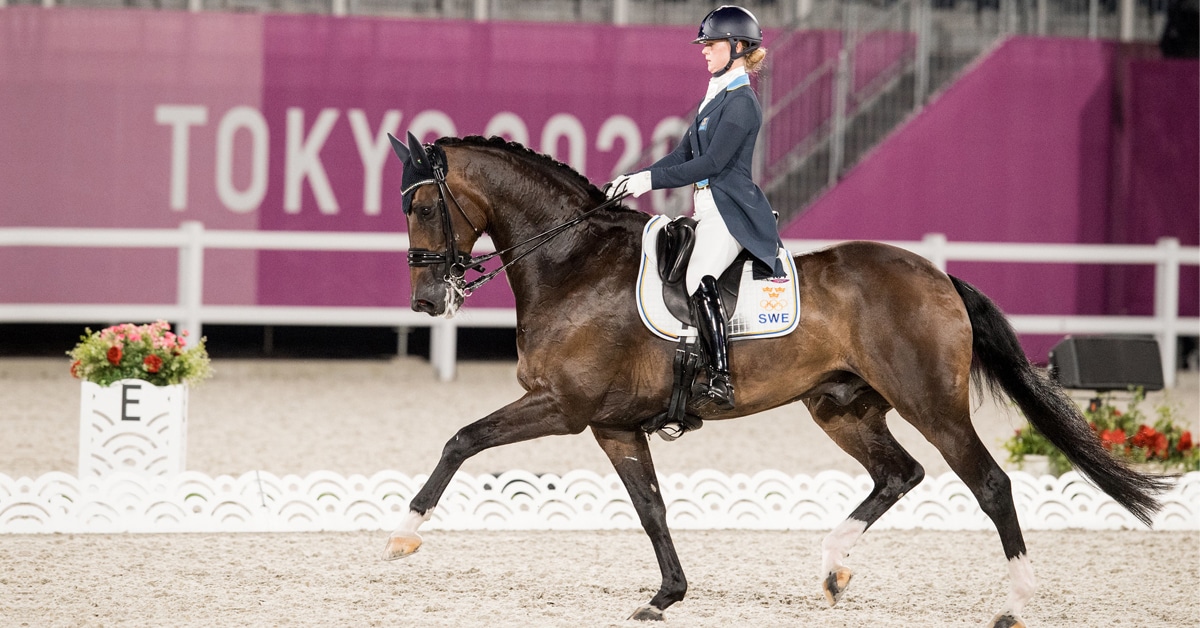Harmony. An often-used buzz word in equestrianism, but what does it mean? It is defined as “the state of being in agreement or concord” and harmony in the equestrian sense is essentially the same, where both horse and rider are working together as one.
There are many elements required from both participants in the attainment of harmony, such as clear communication and mutual trust; however, in terms of rider technique, considerable importance is placed on positioning and use of the pelvis. To coordinate their movements, the rider’s pelvis must move in synchronisation with the horse’s back in a forward and backward motion.

Figure 1. (L to R): Pelvis in anterior tilt, neutral and posterior tilt. (from Centered Riding, S. Swift)
It is commonly perceived that a neutral pelvis, which is not tilted towards the front (anteriorly) or towards the back (posteriorly) is required to achieve harmony (Figure 1). So, it follows that experienced riders will have a neutral pelvis; however, is this something that we can assess objectively in riders? Can we evaluate rider performance using precise quantitative measurements rather than (sometimes flawed) human judgment?
Dr. Celeste Wilkins from the University of Hartpury’s Margaret Giffen Centre for Rider Performance sought to answer these questions in her PhD research. She presented some of her findings at the Saddle Research Trust’s 4th International Conference in December 2021. A link to her full thesis can be found here.
Dr. Wilkins undertook pelvic positioning assessments in competitive female dressage riders, using a riding simulator and Qualisys motion capture, in a controlled laboratory setting (Figure 2). The use of the simulator allowed for the collection of rider data while eliminating environmental and equine variables. All test riders were subjected to identical “horse” movements or oscillations so the calibre of horse didn’t influence results.

Figure 2: Riding simulator and cameras. (C. Wilkins, SRT presentation)
In the literature, as well as in the coaching setting, riders are usually classed by competition level and pelvic posture is assessed when horse and rider are static (stationary). In her initial research, Dr. Wilkins wanted to see if there was a relationship between static and dynamic (in-motion) pelvic posture and whether competition level should be considered (Wilkins et al., 2020).
She determined pelvic tilt in 35 competitive dressage riders, taking measurements for mean, minimum and maximum pelvic tilt along with range of motion (ROM). Results showed that pelvic tilt (anterior, posterior or neutral) is not influenced by competition level; therefore, the theory that to achieve harmony you need to have a neutral pelvis was not proved here. Also, there was no relationship between the static pelvic posture and the mean dynamic pelvic tilt. As Dr. Wilkins put it, “You can’t predict how the rider will move from how they sit.”
As harmony describes the similarity of movement between two bodies ‒ in this case, the horse and the rider ‒ Dr. Wilkins next wanted to see if we could quantify the degree of synchronicity. For this she used the continuous relative phase (CRP) variable which is used extensively in other sports to analyse coordination between two moving bodies. Measuring harmony over the entire movement cycle of the stride, the CRP between rider pelvic pitch and the up-down displacement of the riding simulator was analysed in both medium and extended trot.
When looking at the CRP between different body parts and the simulator movements, none had as strong or consistent coupling between movement cycles as the pelvis. The trunk was significantly more variable than the pelvis, whereas the head and the foot were in turn significantly more variable in their coordination pattern, than the pelvis or trunk. The results suggest that the independent seat achieved through the pelvis is not influenced by the head and feet moving outside of the rhythm of the riding simulator. Interestingly, in simulated extended trot, the greater movement demands resulted in more consistent trunk movement coordination to the riding simulator.

Figure 3 – Strategy 1, peak pelvic posterior tilt (L) and peak pelvic anterior tilt (R).
Can riders be grouped based on the pattern of pelvic movements they use or their strategy to achieve rider harmony? In her research, Dr. Wilkins found three distinct movement patterns in riders. Strategy 1 was characterised by the trunk and pelvis rotating opposite to each other. The pelvis had a high ROM (Figure 3) and small trunk ROM. The riders were not likely to maintain this strategy from medium to extended trot. Strategy 2 was characterised by the trunk and pelvis rotating together where the trunk and pelvis had similar ROMs. However, in extended trot, the trunk ROM increased to make up for the larger movement. Strategy 3 was characterised by the trunk reaching maximal posterior rotation just after the pelvis. There was more pelvis than trunk ROM in medium trot, but similar ROMs for both in extended trot.
It is likely that more movement strategies could be found with an extended group of test participants or with the use of live horses; however, the methods described here provide an informative starting point for analysing riders based on their movements rather than on more subjective measures which may be open to bias. From a coaching perspective, this method of quantifying harmony between horse and rider could have great potential to improve rider technique by providing more informed rider training cues.

